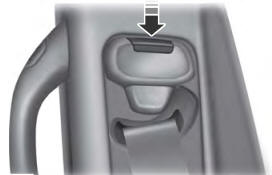Ford Explorer: Power Steering / Removal and Installation - Tie Rod End
Ford Explorer 2020-2025 Service Manual / Chassis / Steering System / Power Steering / Removal and Installation - Tie Rod End
Special Tool(s) / General Equipment
| Tie Rod End Remover |
Removal
NOTE: Removal steps in this procedure may contain installation details.
-
Remove the wheel and tire.
Refer to: Wheel and Tire (204-04A Wheels and Tires, Removal and Installation).
-
-
Loosen the tie rod end jam nut.
Torque: 35 lb.ft (48 Nm)
-
Remove and discard the outer tie rod end nut.
Torque: 52 lb.ft (70 Nm)
-
NOTICE: Do not use a hammer to separate the outer tie-rod end from the wheel spindle or damage to the wheel spindle may result.
NOTICE: Use care when installing the tie rod separator or damage to the outer tie-rod end boot may occur.
Separate the outer tie rod end from the wheel knuckle.
Use the General Equipment: Tie Rod End Remover
-
Loosen the tie rod end jam nut.
.jpg) |
-
NOTE: Count and record the number of turns required to remove the outer tie-rod end for reference during installation.
Remove the tie-rod end.
.jpg) |
Installation
-
To install, reverse the removal procedure.
-
Check and if necessary, adjust front toe.
Refer to: Front Toe Adjustment (204-00 Suspension System - General Information, General Procedures).
 Removal and Installation - Tie Rod
Removal and Installation - Tie Rod
Special Tool(s) /
General Equipment
Boot Clamp Pliers
Materials
Name
Specification
Motorcraft® Premium Long-Life GreaseXG-1-E1
ESA-M1C75-B
Removal
NOTICE:
When ..
Other information:
Ford Explorer 2020-2025 Service Manual: Removal and Installation - Auxiliary Power Point
Special Tool(s) / General Equipment 501-194Remover, Power PointTKIT-2014D-ROW2TKIT-2014D-FL_ROW Removal Open the power point cover. Position the power point extractor so that it engages in the adjacent slots in the power point socket...
Ford Explorer 2020-2025 Owners Manual: Steering
Electric Power Steering WARNING: The electric power steering system has diagnostic checks that continuously monitor the system. If a fault is detected, a message displays in the information display. Stop your vehicle as soon as it is safe to do so...
Categories
- Manuals Home
- 6th Generation Explorer Owners Manual
- 6th Generation Explorer Service Manual
- Description and Operation - Jacking and Lifting - Overview
- Body and Paint
- Engine - 2.3L EcoBoost (201kW/273PS)
- New on site
- Most important about car
Seatbelt Height Adjustment
WARNING: Position the seatbelt height adjuster so that the seatbelt rests across the middle of your shoulder. Failure to adjust the seatbelt correctly could reduce its effectiveness and increase the risk of injury in a crash.

Copyright © 2025 www.foexplorer.com

